Normandie |
|
|
|
| Übersicht – Contents: | |
Diese Seite ist Teil des Projektes
Normandie |
|
|
|
| Übersicht – Contents: | |
Flagge – Flag: |
|
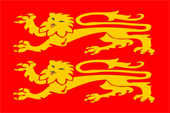 |
Flagge der Normandie - flag of Normandy - Drapeau de Normandie, Quelle/Source, nach/by: Wikipedia (D) |
| andere Flaggen – other Flags: | |
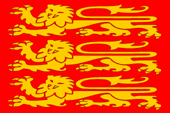 |
Flagge der Normandie als Variante mit drei Leoparden - flag of Normandy
as a variant with three leopards - Drapeau de Normandie comme une
variante avec trois léopards, Quelle/Source, nach/by: Wikipedia (D) |
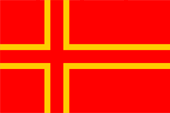 |
Flagge der Normandie mit St.-Olavs-Kreuz - flag of Normandy with cross
of St. Olav - Drapeau de la Normandie avec la croix de St. Olav, Quelle/Source, nach/by: Wikipedia (D) |
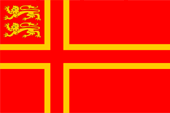 |
Flagge der Normandie mit St.-Olavs-Kreuz und zwei Leoparden - flag of
Normandy with cross of St. Olav and two leopards - Drapeau de la
Normandie avec la croix de St. Olav et deux léopards, Quelle/Source, nach/by: Wikipedia (D) |
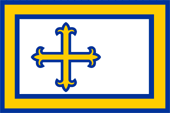 |
Die
legendäre Flagge von Wilhelm dem Eroberer - lengendary flag of William
the Conqueror - le drapeau légendaire de Guillaume le Conquérant Quelle/Source, nach/by: Wikipedia (D) |
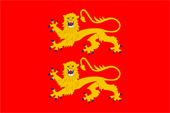 |
1960–2016, inoffizielle Flagge der Unternormandie - unofficial flag of Lower Normandy - drapeau officieux de la région Basse Normandie, Quelle/Source, nach/by: Wikipedia (D) |
 |
1960–2016, inoffizielle Flagge der Obernormandie - unofficial flag of Upper Normandy - drapeau officieux de la région Haute Normandie, Quelle/Source, nach/by: Wikipedia (D) |
 |
1960–2016, inoffizielle Flagge der Obernormandie - unofficial flag of Upper Normandy - drapeau officieux de la région Haute Normandie, -Variant(e)- Quelle/Source, nach/by: www.emblemes.free.fr |
| Die historische Flagge der Normandie war eine Wappenflagge, sie zeigte das Bild des historischen Wappenschildes. | The historic flag of Normandy was a scutcheon-flag. It showed the image of the historic coat of arms. |
| Die zwischen 1960 und 2016 bestehenden Regionen Obernormandie und Unternormandie verwenden beide, wahrscheinlich und ohne Zweifel inoffiziell, ebenfalls die Flagge mit den beiden Löwen, die sich angeblich nur in ihrer Form unterscheiden. Aber das ist nicht sicher, weil gerade in der Obernormandie auch Flaggen mit drei Löwen verwendet werden. | The
between 1960 and 2016 existing Regions of Upper Normandy and lower Normandy,
use both – probably and unofficially without doubt – also the flag with the
two lions that supposedly differ only in the form of the lions. But that is not safe, because even in the Upper Normandy are flags in use, which show the three lions (treis cats). |
| Die Flagge der Normandie ist normalerweise eine Wappenflagge, sie zeigt das Bild des Wappenschildes, zwei goldene Leoparden auf rotem Grund. Diese Heraldik geht auf das Wappen von 1194 zurück. | The flag
of Normandie is usually a scutcheon-flag, it shows the image of the coat of
arms: Two golden leopards on red ground. This heraldry goes back to the year 1194. |
| In der Normandie gibt es jedoch seit den 20er Jahren des 20. Jahrhunderts einen Flaggenstreit, der sich darin äußert, dass eine Version der Flagge mit drei Leoparden verwendet wird, die auf das Wappen von 1189 zurückgeht. | In Normandy there is a flag dispute since the 20s of the 20th century, which manifests itself in the fact, that a version of the flag is used with three leopards, which goes back to the coat of arms of 1189. |
| Von einigen Normannen wird die Flagge mit den zwei Leoparden abgelehnt, weil die Einführung des Wappens mit den zwei Leoparden zeitlich in etwa mit der Eroberung durch Frankreich zusammenfällt, und weil die drei Leoparden an das normannische Königtum erinnern, das seit 1066 in England regierte. | Some Normans, reject the flag with the two leopards, because the introduction of the coat of arms with the two leopards time roughly coincides with the conquest by France, and because the three leopards remember the Norman kingship, which ruled in England since 1066. |
| Um den Streit zu überwinden, wurde Mitte der 70er Jahre des 19. Jahrhunderts eine neue Flagge vorgeschlagen. Sie zeigt auf rotem Grund, im skandinavischen Design, das Kreuz des Heiligen Olav, der in Rouen – Hauptstadt der Normandie – getauft worden war. Diese Flagge setzte sich aber nicht überall durch, ja sie wird sogar stellenweise zusätzlich im Oberecke mit zwei Leoparden ergänzt. | To
overcome the dispute, in the middle of the 70s of the 19th century a new
flag was proposed. It shows on a red background, in Scandinavian design, the
cross of St. Olav. He had been baptized in Rouen - the capital of Normandy. However, this flag did not achieve everywhere, it is even locally in the upper quadrant added by two leopards. |
| Wilhelm II., der Eroberer, Herzog der Normandie und ab 1066 auch König von England, soll eine eigene Flagge gehabt haben, als er England eroberte. Sie wird auf dem Teppich von Bayeux einige male dargestellt. Wilhelm soll diese Fahne von Papst Alexander II. zu seinem Schutz verliehen bekommen haben. | William
II., the Conqueror, Duke of Normandy and from 1066 also King of England,
should even had its own flag, when he conquered England. It is few times reproduced on the Bayeux Tapestry. William should have been awarded this banner by Pope Alexander II. for his protection. |
| Quelle/Source: Volker Preuß, Wikipedia (FR), Wikipedia (D) | |
| Wappen – Coat of arms: | |
 |
12.
Jhd. – 12th cent., Wappen der Normandie – coat of arms of Normandy Quelle/Source, nach/by: Wikipedia (D) |
 |
1189
– 1194, Wappen der Normandie – coat of arms of Normandy Quelle/Source, nach/by: Wikipedia (D) |
 |
ab/from 1194, Wappen der Normandie – coat of arms of Normandy Quelle/Source, nach/by: Wikipedia (D) |
| Das erste Wappen der Normandie wurde Mitte des 12. Jahrhunderts unter der Herrschaft von Gottfried Plantagenet eingeführt. Es zeigte sechs goldene Löwen auf blauem Grund. | The first coat of arms of Normandy was the mid-12th Century introduced under the reign of Geoffrey Plantagenet. It was six golden lions on a blue background. |
| Als Richard I. (Löwenherz) im Jahre 1189 Herzog der Normandie und König von England wurde, wurde sein Wappen, mit den drei goldenen Leoparden auf Rot, auf die Normandie übertragen. Ab 1194 wurde das Wappen mit den drei Leoparden jedoch auch als Wappen des englischen Königtums übernommen, und die Normandie musste darum einen der drei Leoparden abgeben. | When
Richard I. (the Lionheart) in 1189 became Duke of Normandy and King of
England, his coat of arms with the three golden leopards on red was
transferred to the Normandy. From 1194 the coat of arms with the three leopards, however, was adopted as the emblem of the English kingship, and the Normandy had therefore had to cede one of the three leopards. |
| Quelle/Source: Wikipedia (D) | |
| Lesen Sie
hier:
Eine Flaggen-Affäre! "Vom königlichen Bannerwurf zur Geiselhaft". Die Probleme von Richard I. (Löwenherz), König von England, mit einer ungeliebten Flagge! |
 |
|
Lesen Sie hier: Hintergründe, Geschichte und Fakten zum Thema "Der Löwe in der Heraldik". Ausführungen, Varianten, Entwicklung, sowie Panther und Leoparden. |
 |
|
Die Regionen: Die historischen, französischen Regionen – The historical, french Regions |
|
|
in Schwarz: Provinz und Gouvernement im Jahre 1776, in Rot: ehemalige
Grafschaft, Provinz oder Gouvernement – in black: governorate and province in 1776, in red: former county, province oder governorate |
| Landkarte/Map: Volker Preuß |
| Erläuterungen zu den Regionen | Explanation about the Regions |
| Die bis zur Französischen Revolution bestehenden Provinzen (bzw. Gouvernements) waren historisch gewachsene Gebilde, die sich oft aus ehemaligen Lehensgebieten der französischen Krone, historischen Grafschaften und Herzogtümern heraus entwickelt hatten, oft über hunderte von Jahren bestanden und Regionalität (kulturelle Besonderheiten und regionale Sprachen) bewahrt hatten. Der Französischen Revolution waren solche Erscheinungen natürlich nicht erwünscht, und im Rahmen ihrer blutigen und gewalttätigen Gleichmacherei wurden jegliche regionale Bezüge ausgemerzt. Kurz nach der Revolution wurden die Provinzen aufgelöst und Frankreich in viele kleine Départements aufgeteilt, die annähernd gleich groß und den gleichen Status haben sollten. Benannt wurden die Départements nach Flüssen oder Gebirgen, um auf keinen Fall den Namen einer der alten Provinz zu verwenden. Es gelang jedoch nicht, die Verbindungen der Einwohner Frankreichs zu ihrer jeweiligen Region abzuschneiden, so dass im Jahre 1960 wieder administrative Regionen geschaffen wurden, um bestimmte Verwaltungsprozesse regional steuern zu können. Dazu wurden Départements, die in einer bestimmten historischen Provinz lagen, zu einer historisch oft gleichnamigen Region administrativ zusammengefasst. Die dabei entstandenen Gebilde decken sich nur annähernd mit den Grenzen der historischen Provinzen. Im streng zentralistischen Frankreich wird jedwede Regionalität vermieden, so dass auch die offiziellen Flaggen dieser Regionen meist aussehen wie Flaggen von Firmen, lieblos, unhistorisch, technokratisch und modernistisch, die hier nicht Gegenstand lexikalischer Betrachtungen sein sollen. Nur in wenigen dieser Regionen gibt es offizielle Flaggen die an historische Vorbilder erinnern. Aber, sogar die Existenz dieser heutigen Regionen ist in Frage gestellt, denn im Jahr 2014 wurde eine Gebietsreform beschlossen, welche die Anzahl der Regionen ab dem Jahr 2016 durch Fusionen auf fast die Hälfte verringert. Jedoch gibt es für fast alle Regionen inoffizielle Flaggen, die an die alten Provinzen und die alte Heraldik erinnern sollen. | The until
the French Revolution existing provinces (or governorates) have been
historically grown structures, which had their roots oftenly in former
fiefdoms of the French crown, historic counties and duchies. They oftenly
existed for hundreds of years and had preserved regionality (e.g. cultural
particularities and regional languages). On the occasion of the French
Revolution such phenomena were of course not desirable, and as part of their
bloody and violent egalitarianism any regional references were eliminated. Shortly after the French Revolution the provinces were dissolved and France became divided into many départements, which should have approximately the same size and the same status. The départements were named after rivers or mountains, to use never and in no circumstances the name of an old province. However, there was no success in cutting the connections of the people of France to their respective regions, so that administrative regions were re-created in 1960, to have a better control in regional administrative processes. In this way became départements, which were placed in a historical province, administratively grouped to an oftenly historically named region. The resulted structures coincide only approximately with the boundaries of the old provinces. In the strictly centralist France any regionality is avoided, so that even the official flags of these regions mostly look like flags of companies, unloving, unhistorical, technocratic and modernistic, and these flags should not be a subject of any lexical considerations here. Only in a few of that regions, exist official flags which remember the historical models. But, even the existence of these today's regions is douptful, because in 2014 was passed a territorial reform valid from the year 2016, that reduces the number of the existing regions by merging to nearly the half. However, there exist unofficial flags in nearly all of these regions, which should remember the old provinces and the old heraldry. |
|
Wikipedia-Link zu den Regionen Frankreichs:
hier klicken FOTW-Link zu den Regionen Frankreichs: hier klicken |
Wikipedia
Link to the regions of France:
click here FOTW Link to the regions of France: click here |
| Quelle/Source: Flags of the World, Wikipedia (D), Volker Preuß | |
| Zahlen und Fakten – Numbers and Facts: | |
|
Die historische Provinz Normandie gliederte sich zwischen 1960 und 2016 in zwei Regionen: • Basse-Normandie (Niedernormandie) und • Haute-Normandie (Obernormandie) |
The historical province of Normandy was divided into two regions between 1960 and 2016: • Basse-Normandie (Lower Normandy) and • Haute-Normandie (Upper Normandy) |
|
|
|
|
|
|
|
|
|
|
|
|
|
Antike
· Besiedelung durch keltische Stämme, deren größte die Kaleter und Veneller
sind 56 v. Chr. · römische Eroberung, zur Provinz Gallia Lugdunensis 5. Jahrhundert n. Chr. · der Westen des Landes schließt sich dem Bund von Armorica zum Schutz gegen germanische Einfälle an, der Osten des Landes wird von den Franken erobert 880 · Vertrag von Verdun und Ribbemont, bei der Teilung des Frankenreiches kommt die heutige Normandie formell an das Westfränkische Reich (Frankreich) 886–911 · die Normannen erobern das Gebiet der heutigen Normandie 912 · Karl der Einfältige, König von Frankreich, verheiratet seine Tochter Gisela mit Rollo dem Herzog der Normannen, der als Robert I. zum Herzog der Normandie erhoben wird und auch die Bretagne zum Lehen erhält 942 · Beginn der Herrschaft von Richard I., Enkel von Robert I., Abwehr von französischen und angelsächsischen Angriffen 1035 · Beginn der Herrschaft Wilhelm II., der Eroberer, Enkel von Richard I., er kann seinen Besitz der Normandie behaupten, unterstützt den angelsächsischen König Eduard gegen die Dänen, und tritt so dessen Erbe an 1066 · Wilhelm II. schlägt den angelsächsischen König Harald bei Hastings und lässt sich zum König von England ausrufen 1087 · Tod von Wilhelm II., sein ältester Sohn, Robert II., wird Herzog der Normandie, sein jüngster Sohn, Heinrich I., wird König von England 1101 · Robert II. kehrt vom Kreuzzug zurück und beansprucht auch die Krone von England für sich 1106 · Heinrich fällt in der Normandie ein und besiegt Robert bei Tinchebrai und vereinigt die Normandie und England unter seiner Krone 1135 · Tod von Heinrich I., sein Schwiegersohn, Gottfried Plantagenet, Graf von Anjou, wird Herzog der Normandie, jedoch hatte bereits König Ludwig VI. von Frankreich den Grafen Stephan von Blois, einen Neffen König Heinrichs I., die Normandie zum Lehen gegeben 1144 · Gottfried Plantagenet setzt sich als Herzog der Normandie durch 1150 · Heinrich II., Sohn von Gottfried Plantagenet wird Herzog der Normandie 1154 · Heinrich II. wird auch König von England 1189 · Richard I. (Löwenherz) wird König von England und Herzog der Normandie 1204 · der französische König Philipp August beansprucht die Normandie und besetzt das Land, in den Folgejahren Kämpfe zwischen Frankreich und England um die Normandie 1259 · der englische König Heinrich III. tritt die Normandie an Ludwig den Heiligen, König von Frankreich ab 1315 · Ludwig X., König von Frankreich, erlässt die 'Charte Normande', das Herzogtum behält seine eigne Gerichtsbarkeit und Rechtsverfassung 1346 · Eduard III., König von England, erobert die Normandie 1417–1419 · Hundertjähriger Krieg, Heinrich V., König von England, erobert und besetzt kurzzeitig die Normandie 1450 · Karl VII., König von Frankreich, bringt die Normandie endgültig an Frankreich, die Thronerben Frankreichs trugen fortan den Titel 'Herzog der Normandie', die Normandie wird später ein Gouvernement (Provinz) 1776 · die schon im 14. Jahrhundert geschaffenen Gouvernements der Zivilverwaltung des Königreiches Frankreich werden auf eine Anzahl von 39 Stück festgeschrieben und entsprechen so der Anzahl der Provinzen, in den Vorjahren konnten auch mehrere Provinzen in einem Gouvernement zusammengefasst sein 1789 · Französische Revolution, die Gouvernements (Provinzen) werden abgeschafft, die Normandie wird in Départements zerlegt 1960 · Wiedereinführung von Regionen in Frankreich, jedoch keine einheitliche Normandie und nicht innerhalb historischer Grenzen, sondern Bildung der Regionen Obernormandie und Unternormandie, dabei Einbindung der Departements Manche, Calvados und Orne (Obernormandie), sowie Seine-Inférieure und Eure (Unternormandie) 2016 · die Regionen Obernormandie (Haute-Normandie) und Unternormandie (Basse-Normandie) gehen zusammen in der neuen größeren Region Normandie auf (Hauptstadt: Rouen) |
|
antiquity
· settlement by Celtic tribes, the largest of them are the Kaleters and
Venellers 56 B.C. · Roman conquest, to the province of Gallia Lugdunensis 5th century A.D. · the west of the country joins the Federation of Armorica to find protection against Germanic invasions, the east of the country was conquered by the Franks 880 · Treaty of Verdun and Ribbemont, at the division of the Frankish Empire comes the today's Normandy formally to the West Frankish Kingdom (France) 886–911 · the Normans conquer the territory of the today's Normandy 912 · Charles the Simple, King of France, marries his daughter Gisela with Rollo, Duke of the Normans, who gets, as as Robert I., the title of the Duke of the Normandy and even the Brittany as a fief 942 · beginning of the reign of Richard I. , grandson of Robert I., defence of French and Anglo-Saxon attacks 1035 · beginning of the reign Wilhelm II., the conqueror, grandson of Richard I., he can claim his possession of Normandy and supported the Anglo-Saxon King Edward against the Danes, and shall have the Heritage for that 1066 · William II. defeats the Anglo-Saxon King Harold at Hastings and gets proclaimed as king of England 1087 · death of William II., his eldest son, Robert II., becomes Duke of Normandy, his youngest son, Henry I., becomes King of England 1101 · Robert II. comes back from the Crusades and claimes also the crown of England for himself 1106 · Henry invades Normandy and defeats Robert at Tinchebrai and unites Normandy and England under his crown 1135 · death of Henry I., his son Geoffrey Plantagenet, Count of Anjou, becomes Duke of the Normandy, however, already the King of France, Louis VI., had given the Normandy as a fief to Count Stephen of Blois, a nephew of King Henry I. 1144 · Geoffrey Plantagenet establishes finally its rule as Duke of Normandy 1150 · Henry II., son of Geoffrey Plantagenet, becomes is Duke of Normandy 1154 · Henry II., becomes also King of England 1189 · Richard I. (Lionheart) becomes King of England and Duke of the Normandy 1204 · the French King Philip Augustus claimes the Normandy and occupies the country, in the following years fights between France and England for Normandy 1259 · the English King Henry III., cedes the Normandy at the King of France, Saint Louis 1315 · Louis X., King of France, passes the 'Charte Normande', the Duchy maintains its own jurisdiction and constitutional law 1346 · Edward III., King of England, conquers Normandy 1417–1419 · Hundred Years' War, Henry V., King of England, conquers and occupies the Normandy temporarily 1450 · Charles VII., King of France, brings the Normandy finally to France, the heirs of the throne of France wore henceforth the title 'Duke of Normandy', The Normandy becomes later a governorate (province) 1776 · the already in the 14th century created governorates of the civil administration of the kingdom of France become committed to a number of 39, and correspond in this way to the number of provinces, in previous years could any provinces be summarized in one governorate 1789 · French Revolution , the governorates (provinces) become abolished, the Normandy is divided into departments 1960 · reintroduction of regions in France, however, none unified Normandy and not within historical boundaries, but formation of the Regions of Upper Normandy and Lower Normandy, just by integrating the departments of Manche, Calvados and Orne (Lower Normandy), further Seine-Inférieure and Eure (Upper Normandy) 2016 · the Upper Normandy (Haute-Normandie) and Lower Normandy (Basse-Normandie) regions merge in the new, larger region of Normandy (Normandie, capital: Rouen) |
| Quelle/Source: Wikipedia (D), Atlas zur Geschichte, Meyers Konversationslexikon, Taschenatlas Weltgeschichte |
| Der Name des Landes "Normandie" geht auf die Normannen zurück, die sich hier am Ende des 10. Jahrhunderts ansiedelten und deren Nachfahren bis heute hier leben und ihre eigene Sprache und Kultur behalten haben. | The name of the Country "Normandy" goes back to the Normans, which settled here at the end of the 10th century, and their descendants live here until today and maintain their own language and culture. |
| Quelle/Source: Volker Preuß | |